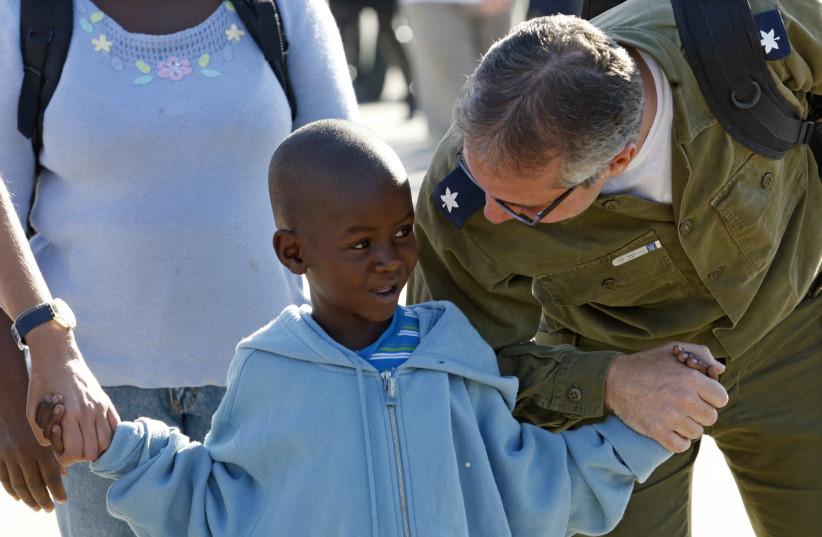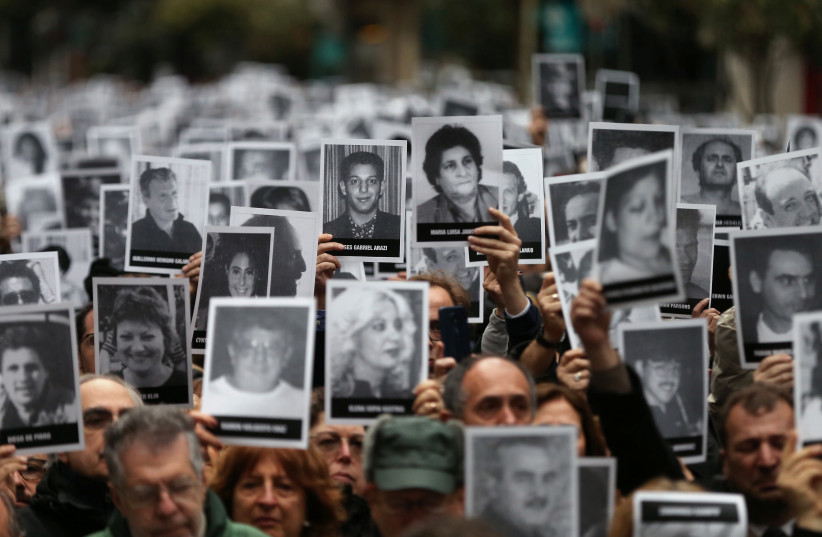In 2010, a major earthquake struck Haiti, killing up to 300,000 people and causing billions of dollars in damage. In Israel, IDF Col. Zohar Moshe heard about the earthquake and began assembling a team to help in the rescue operation. Working through the Foreign Ministry, a team was dispatched.
They had to wait precious hours for permission from the Haitian government before making the 15-hour trip to the Caribbean country. Arriving with dozens of personnel, they set up a field hospital, and Moshe and his team of search-and-rescue experts assisted in the days after the earthquake.
“When we got there we began to go around the city, and we discovered it was different than anything we’d seen before,” he recounts. “Around 80% of [the capital] Port-au-Prince was destroyed. So the goal was different; we had to go through the city and stop near buildings and begin to check if there were calls [for help] from within the buildings.”
Recent earthquakes in Israel have reminded many people of the dangers lurking beneath the surface that could cause widespread destruction. An earthquake measuring a magnitude of 4.2 was felt on Sunday, January 23, which followed one less than 24 hours earlier, a 3.8 magnitude tremor. They were felt in Haifa, Tiberias and across the North, and even as far as the Jordan Valley. The last time a major earthquake struck was in 1927, when hundreds were killed. The Institute for National Security Studies (INSS) at Tel Aviv University has argued an earthquake is a major danger.
“Thousands dead, tens of thousands injured, and hundreds of thousands forced to evacuate their homes: this is the expected scenario that will accompany the powerful earthquake that sooner or later will strike Israel. Although currently the State of Israel is not doing enough to prepare for this event, it is incumbent on it to prepare for this deadly episode, which constitutes a significant threat to national security,” INSS said in late 2021.
Interviews with key IDF officers involved in foreign rescues, such as those in Argentina, Haiti and Florida, reveal the extent to which Israel has learned from the past and offered its assistance abroad.
THE HOME Front Command operates search-and-rescue units. Its National Rescue Unit is made up primarily of soldiers in the reserves, and the unit has a small number of active duty soldiers. The unit is run by a colonel and is designed to perform special rescue operations in Israel and abroad. The rescue unit conducts annual exercises to maintain its professionalism and capabilities, and can be sent at a moment’s notice with expert personnel and specialized equipment.
In Haiti, after the earthquake, Israel established an operation on a soccer field near the airport. Israel assisted more than 1,100 patients and helped deliver 16 births during the crisis.
Moshe recalls the harrowing events today. One key issue was having a local Israeli and member of the Jewish community who could help assist. This is because landing in a foreign environment where people speak a different language already presents hurdles. During a crisis these hurdles are acute. The Israeli had been in Haiti for 30 years and was able to provide information, Moshe says.
The search-and-rescue aspect of the operation involved sending teams of several people each to go street by street to search for survivors. A local resident helped get a radio to transmit to people to call locally, and he would relay the information for help to the Israelis. One man was saved by this method. “The unit went out to help and heard someone in the rubble,” Moshe recalls.
Unfortunately, after that, the good news faded. Further searching did not turn up many more survivors.
“We kept looking for another week and we found only bodies,” Moshe says. “We began to look for other possibilities to assist. Many people were now homeless and afraid to return home due to aftershocks, so the displaced people were there, and we wanted to look for a way to help them. After a week and a half, the chances of finding people was near zero.”
One more man, Emanuel Bito, was rescued after 10 days in the rubble. He was lucky in the manner in which the earthquake had collapsed his home, leaving him some space in his apartment to get to food and water.
Moshe says the team looked for other humanitarian assistance it could provide and it worked with USAID. The local Israeli helped get kits for water tanks, and the team worked with him. “Instead of people waiting three hours for a water truck, they had water all day long.”
The team stayed for two weeks before returning to Israel. US forces took over the work of the Israeli field hospital. “That was the point that we could leave Haiti, after doing everything we could,” he recalls.
One of the lessons learned was that arriving on the scene of an earthquake even without large tools for excavating can still enable a team to save lives. “Because most of the things we brought were part of the field hospital. So the rescue group could only bring what can go in a hospital, what you can carry in your hands.... We learned what’s important in terms of information, receiving it from the population, so you can get to the places where there are people living,” the reserve officer says.
Israel conducts training every year and is trying to be as prepared as possible for an earthquake. The reserve officer says that if something like what happened in Haiti occurred here, preparing for this kind of tragedy is what the Home Front Command is doing. “From every event we try to learn and [get] experience. The last experience was in Miami, and we learned a lot from that experience,” he says, referring to the Surfside building collapse in southeastern Florida last year.
What Israel has learned over the decades is to use information to put together the best picture of who and what might be in the rubble. This means combining the latest technology and engineering knowledge as well as working with the population.
Israel does a lot of drills and expects to be prepared for an earthquake. However, the fear that it could happen any day or month in the coming years should raise concerns. Moshe says he and his fellow rescuers pray that they meet only in drills, and not in the face of a reality like a catastrophic earthquake.
Col. Amir Golan was central to the rescue effort in Argentina, and a movie was later made about Israel’s rescue efforts. The national rescue unit at the time was in transition. He says it had been rebuilt in time for the operation. It had been active as a rescue unit during the First Gulf War when Saddam Hussein’s Iraq rained Scud missiles down on Israel. The unit had a different structure at the time, he says.
“It was decided to establish the Home Front Command, and as a part of this restructuring, the unit was restructured also and we were built in a military manner of structure, which includes a commander and three groups under the commander,” he recalls. “I was the commander of one of the three units belonging to the National Rescue Unit. We were training for a year or more how to rescue people and we had enough experience from the First Gulf War,” he says.
The group of reservists that made up the unit was sent to Argentina as soon as news arrived of the destruction of the building. “We were called for active duty and it didn’t take us very long to take off on a military plane with some 40-50 rescuers [who had] different jobs and professions. We went to Argentina to try to rescue people in the Jewish community building, the AMIA,” he recalls.
Arriving in the city, they were driven to the site. It was chaotic upon arrival. “Not only was there rubble but also a lack of combined effort. Every separate authority in Argentina and Buenos Aires worked separately; the Jewish community separate from the firefighters and firefighters separate from the police. And many people not belonging to any organization just entered the site and were trying to do something.”
This bad situation had to be sorted out. The IDF unit helped organize the activity and began working 24 hours a day in shifts. “Unluckily, we couldn’t find anyone alive because of the type of the collapse. The building was built over different periods of time and had been enlarged and heightened. What happened is that the car bomb exploded below the building – some type of entryway below the building designed to unload commercial loads – and unluckily they had been able to go in and bomb the building in a manner that didn’t give much chance for people to survive,” he says.
Most people were killed by the collapse. The goal of the rescue became to recover the bodies, many of whom were from the Jewish community. The people needed a proper burial, an issue close to the hearts of Israelis, who know the meaning of burying the dead from wars and acts of terror.
There were also efforts to retrieve the paperwork in the building, such as lists with people’s home and work addresses, which terrorists might have wanted to access. There was also “money in safes and other property belonging to those in the building when it collapsed, and we were suspecting that some of the people who came in were interested in that.” This added to the complexities of the rescue and put an emotional burden on the team.
The Jewish community was active in the search. “What was emotional for us was the kids and youngsters from the Jewish community who were arranged by the community to help us, in simple labors like hauling buckets of sand and rubble, and they were very enthusiastic about working with us, we were very enthusiastic to see so many Jewish youngsters there who were ready to come and do a tough job in low temperatures,” he says.
Recovering the bodies was difficult. They were deformed from the collapse and over time the smell of the dead became unpleasant. “We were there some seven days and nights, the smell and the views were even worse than what we found on the first days... we were very new to that situation, It was an experience that cannot be forgotten.” Eighty-two bodies were found and given to the community for burial. The unit was exhausted and eventually bid farewell to the community and returned to Israel.
Golan says the lessons learned have helped Israeli rescues up to the present day. The cumulative experience over the years had been of great benefit, he says. One aspect is understanding the unique role of the local Jewish community in aiding efforts. He recalls how this was important in Haiti and Florida’s Surfside collapse in June. Golan says he carries with him to this day the memories of the local community in Argentina.
Another lesson learned over the years is the importance of knowledge and technical abilities to pick through the rubble in the best way possible to locate people. This can be compiled before the unit departs so that it will concentrate on the right areas upon arrival. The unit is prepared to leave 24 hours a day, seven days a week “to save lives all over the world, in Israel and where we are needed, where we are asked and welcome,” says Golan.
The IDF provided on-site assistance from June 27 for 14 days. In the first 48 hours, the team was able to try and pinpoint areas where there might be missing people, using the latest technology. “They agreed to dig and work according to our pinpointing [and] because of that we found all the missing [bodies] in a short time. In less than 14 days we found the missing and learned a lot from them [the Americans] and contributed what we had.”
The Surfside collapse was a disaster of exceptional proportions because the building pancaked as it collapsed, leaving little hope of survival. Any rescue team arriving on a site knows that the first 72 hours are crucial for finding people alive. “It’s like starting a marathon right after another marathon,” the rescuer recalls. “The chances after 72 hours to find someone alive, it’s a small percent,” he says. This means procedures for approving foreign support for rescues is important, because every second counts.
“For me, as a commander, to understand what kind of event I’m facing is the main challenge. In the first few hours when we understood that this is a building collapse, either a tower or residential apartment, it influences my decision-making,” he recalls. “In this kind of event we need a specific specialist, such as engineers and intelligence officers and, of course, search and rescue experts and technicians,” says Vach. “If it was a different event such as a hurricane we would take most of these experts but would replace them with other professions. So each disaster means different experts.”
In Surfside there were 98 missing people. The goal was to find them all, even if only to give them a proper burial. This means delicate work not to harm the remains of the people. Vach notes that with the pancake collapse, passing over two to three layers with a bulldozer could hurt the missing people, “so the amount of missing, and the type of collapse” was challenging. The environment was also a challenge because of the risk of hurricanes, the heat and humidity and the smoke and fire from the rubble. It was an extreme scenario, he says. Americans who participated said the challenges were worse than 9/11, although on a smaller scale.
This kind of collapse is a very real danger in Israel. After the team returned there was a building in Holon that was evacuated less than 32 hours before it collapsed in a pancake. It was only luck that a firefighter had seen a door stuck due to structural failure and had called for the evacuation. “It happened. I couldn’t believe it happened here in Israel, in the same type of collapse and in the middle of the day and almost without warning,” he recalls. “Luckily we had this fireman who evacuated them.” The State of Israel is well aware of this risk of structural failure because of the ages of the buildings, he says. Many buildings were constructed quickly and cheaply in the 1950s and 1960s to house the massive waves of aliyah during that period.
Around 10 buildings have been evacuated in Israel since the Surfside collapse due to cracks and other issues. “We are facing the same problem and we are planning the right solution to deal with it,” Vach says.
In terms of rescues, Israel now has the latest technology and methods to locate people in case of disasters. “The Surfside [disaster] taught us to be more accurate and pinpoint the right location in a short time. [It taught us] how to question the families in the right ways so they can locate the precise position of the missing people.
“We developed a new application that helps us to mark the findings. There are thousands of items found on site. If you mark them with a specific application, you can get a better picture of where you are at this exact moment, so you can plan the next steps according to these findings,” says Vach.
Israel has also conducted drills involving trying to find hundreds of missing people, doubling its capability after the Surfside experience, Vach notes.ISRAEL’S FOREIGN operations have helped in learning lessons that can be applied at home. It also helps in terms of sharing expertise with those in places like the US.
A larger country like the United States has awesome capabilities that are more difficult to achieve in Israel. That means learning from the logistics and capabilities that America has. It means forming professional relationships that can aid both countries in the future. If Israel has a mass disaster it will accept the US’s help and observe and learn from the Americans’ assistance.
Sharing of information and assistance could also involve new Abraham Accords partners, and other joint drills have recently put Israel together with Greece, Cyprus, Bahrain and the UAE.
All of these activities have crucial ramifications for facing natural disasters, as well as the disasters that can come with a major conflict.



